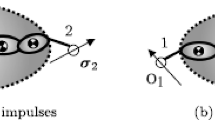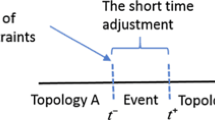Abstract
A new method is presented for accurately and efficiently simulating multi-scale multibody systems with discontinuous changes in system definitions as encountered in adaptive switching between models with different resolutions as well as models with different system topologies. An example of model resolution change is a transition of a system from a discrete particle model to a reduced order articulated multi-rigid body model. The discontinuous changes in system definition may be viewed as an instantaneous change (release or impulsive application of) the system constraints. The method uses a spatial impulse–momentum formulation in a divide and conquer scheme. The approach utilizes a hierarchic assembly–disassembly process by traversing the system topology in a binary tree map to solve for the jumps in the system generalized speeds and the constraint impulsive loads in linear and logarithmic cost in serial and parallel implementations, respectively. The method is applicable for systems in serial chain as well as kinematical loop topologies. The coupling between the unilateral and bilateral constraints is handled efficiently through the use of kinematic joint definitions. The equations of motion for the system are produced in a hierarchic sub-structured form. This has the advantage that changes in sub-structure definitions/models results in a change to the system equations only within the associated sub-structure. This allows for significant changes in model types and definitions without having to reformulate the equations for the whole system.
Similar content being viewed by others
References
Piedboeuf, J., Gonthier, Y., McPhee, J., Lange, C.: A regularized contact model with asymmetric damping and dwell-time dependent friction. Multibody Syst. Dyn. 11, 209–233 (2004)
Bei, Y., Fregly, B.J.: Multibody dynamic simulation of knee contact mechanics. Med. Eng. Phys. 26(9), 777–789 (2004)
Glocker, C., Pfeiffer, P.: Multiple impacts with friction in multibody systems. Nonlinear Dyn. 7, 471–497 (1995)
Pfeiffer, F.G.: Applications of unilateral multibody dynamics. Philos. Trans. Roy. Soc. Lond. 359(1789), 2609–2628 (2001)
Pfieffer, F., Glocker, C.: Multibody Dyanmics with Unilateral Constraints. CISM Courses and Lectures, vol. 421, International Centre for Mechanical Sciences. Springer, New York (2000)
Stewart, D.E.: Rigid-body dynamics with friction and impact. SIAM Rev. 42(1), 3–39 (2000)
Ambrósio, J.A.C., Pereira, M.S., Dias, J.P.: Crashworthiness analysis and design using rigid-flexible multibody dynamics with applications to train vehicles. Int. J. Num. Method. Eng. 40(4), 655–687 (1997)
Ambrósio, J.A.C., Pereira, M.S., Dias, J.P.: Contact and impact models for vehicle crashworthiness simulation. Int. J. Crashworth. 8, 73–86 (2003)
Barhorst, D.: Issues in computing contact forces for non-penetrating rigid bodyes. Algoritmica 10, 292–352 (1993)
Keller, J.B.: Impact with friction. J. Appl. Mech. 53(1), 1–4 (1986)
Lötstedt, P.: Mechanical systems of rigid bodies subject to unilateral constraints. SIAM J. Appl. Math. 42(2), 281–296 (1982)
Trinkle, J., Zeng, D., Sudarsky, S., Lo, G.: On dynamic multi-rigid-body contact problems with Coulomb friction. Z. Angew. Math. Mech. 77(4), 267–279 (1997)
Wu, S., Haug, E.J., Yang, S.M.: Dynamics of mechanical systems with Coulomb friction, stiction, impact and constraint addition–deletion. Mech. Mach. Theory 21(5), 401–425 (1986)
Ferris, M.C., Mangasarian, O.L., Pang, J.S.: Complementarity: applications, algorithms and extensions. In: Applied Optimization, vol. 50. Kluwer Academic, Dordrecht (2001)
Brenan, K.E., Campbell, S.L., Petzold, L.R.: Numerical Solutions of Initial-value Problems in Differential-Algebraic Equations. North-Holland, New York (1989)
Anderson, K.S.: An order-n formulation for the motion simulation of general multi-rigid-body tree systems. Comput. Struct. 46(3), 547–559 (1993)
Rosenthal, D.E.: An order n formulation for robotic systems. J. Astronaut. Sci. 38(4), 511–529 (1990)
Jain, A.: Unified formulation of dynamics for serial rigid multibody systems. J. Guid. Control Dyn. 14(3), 531–542 (1991)
Featherstone, R.: The calculation of robotic dynamics using articulated body inertias. Int. J. Robot. Res. 2(1), 13–30 (1983)
Anderson, K.S., Sadowski, M.J.: An efficient method for contact/impact problems in multibody systems: tree topologies. In: Proceedings of the Fourth International Symposium on Multibody Dynamics and Vibrations, ASME Design Engineering Technical Conference 2003, (DETC03), number DETC03/VIB-48338, Chicago, IL, 2–6 September 2003
Seabra Pereira, M., Nikravesh, P.: Impact dynamics of multibody systems with frictional contact using joint coordinates and canonical equations of motion. Nonlinear Dyn. 9, 53–71 (1996)
Featherstone, R.: A divide-and-conquer articulated body algorithm for parallel O(log (n)) calculation of rigid body dynamics. Part 1: Basic algorithm. Int. J. Robot. Res. 18(9), 867–875 (1999)
Mukherjee, R., Anderson, K.S.: An orthogonal complement based divide-and-conquer algorithm for constrained multibody systems. Nonlinear Dyn. 48(1–2), 199–215 (2007)
Featherstone, R.: Robot Dynamics Algorithms. Kluwer Academic, New York (1987)
Mukherjee, R., Anderson, K.S.: A logarithmic complexity divide-and-conquer algorithm for multi-flexible articulated body dynamics. J. Comput. Nonlinear Dyn. 2(1), 10–21 (2007)
Kim, S.S., VanderPloeg, M.J.: Generalized and efficient method for dynamic analysis of mechanical systems using velocity transforms. J. Mech. Transm. Autom. Des. 108(2), 176–182 (1986)
Nikravesh, P.E.: Systematic reduction of multibody equations to a minimal set. Int. J. Nonlinear Mech. 25(2–3), 143–151 (1990)
Forrest, L.R., Crozier, P.S., Stevens, M.J., Woolf, T.B.: Molecular dynamics simulation of dark-adapted rhodopsin in an explicit membrane bilayer: coupling between local retinal and larger scale conformational changes. J. Mol. Biol. 333, 493–514 (2003)
Kane, T.R., Levinson, D.A.: Dynamics: Theory and Application. Mcgraw-Hill, New York (1985)
Flaherty, J.E., Loy, R.M., Ozturan, C., Shephard, M.S., Szymanski, B.K., Teresco, J.D., Ziantz, L.H.: Parallel structures and dynamic load balancing for adaptive finite element computations. Appl. Numer. Math. 26(1–2), 241–263 (1998)
Featherstone, R.: A divide-and-conquer articulated body algorithm for parallel O(log (n)) calculation of rigid body dynamics. Part 2: Trees, loops, and accuracy. Int. J. Robot. Res. 18(9), 876–892 (1999)
Author information
Authors and Affiliations
Corresponding author
Additional information
R.M. Mukherjee is now at Jet Propulsion Laboratory, Pasadena, California
Rights and permissions
About this article
Cite this article
Mukherjee, R.M., Anderson, K.S. Efficient methodology for multibody simulations with discontinuous changes in system definition. Multibody Syst Dyn 18, 145–168 (2007). https://doi.org/10.1007/s11044-007-9075-1
Received:
Accepted:
Published:
Issue Date:
DOI: https://doi.org/10.1007/s11044-007-9075-1




